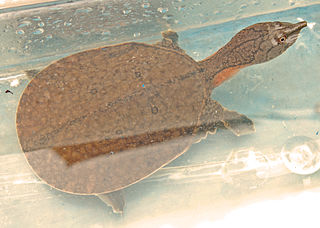
Chelidae is one of three living families of the turtle suborder Pleurodira, and are commonly called Austro-South American side-neck turtles. The family is distributed in Australia, New Guinea, parts of Indonesia, and throughout most of South America. It is a large family of turtles with a significant fossil history dating back to the Cretaceous. The family is entirely Gondwanan in origin, with no members found outside Gondwana, either in the present day or as a fossil.

Trachemys is a genus of turtles belonging to the family Emydidae. Members of this genus are native to the Americas, ranging from the Midwestern United States south to northern Argentina, but one subspecies, the red-eared slider, has been introduced worldwide. Species under this genus are commonly referred to as sliders.

Heosemys is a genus of freshwater turtles in the family Geoemydidae. The genus Heosemys was split out of the related genus Geoemyda by McDowell in 1964.

The eastern long-necked turtle is an east Australian species of snake-necked turtle that inhabits a wide variety of water bodies and is an opportunistic feeder. It is a side-necked turtle (Pleurodira), meaning that it bends its head sideways into its shell rather than pulling it directly back.

Chelodina, collectively known as snake-necked turtles, is a large and diverse genus of long-necked chelid turtles with a complicated nomenclatural history. Although in the past, Macrochelodina and Macrodiremys have been considered separate genera and prior to that all the same, they are now considered subgenera of the Chelodina, further Macrochelodina and Macrodiremys are now known to apply to the same species, hence Chelydera is used for the northern snake-necked turtles.

The Indian narrow-headed softshell turtle, also known as the small-headed softshell turtle or the Indo-Gangetic softshell turtle, is an endangered species of softshell turtle native to waterways and rivers of the Indian subcontinent. It is very large, feeding on fish, frogs, worms, crustaceans and molluscs, and even the occasional swimming small rodent or other mammal. C. indica, like other softshell turtles, uses it flexible shell to dig itself deep into sandy lake and river bottoms; here, it patiently waits for potential prey to swim by. They will also ambush and chase their prey, depending on availability, the time of year, and size of the prey. In the past it was included as a subspecies of Chitra chitra, a species restricted to Southeast Asia using current taxonomy.

The Asian giant softshell turtle, also known commonly as Cantor's giant softshell turtle and the frog-faced softshell turtle, is a species of freshwater turtle in the family Trionychidae. The species is native to Southeast Asia. The species is critically endangered and in the 20th century has disappeared from much of its former range.

Oldham's leaf turtle is a species of turtle in the family Geoemydidae.

Pelochelys is a genus of very large softshell turtles in the family Trionychidae. They are found from peninsular India northeast to southern China, and south to Southeast Asia and New Guinea.

Trionychia is a superfamily of turtles which encompasses the species that are commonly referred to as softshelled turtles as well as some others. The group contains two families, Carettochelyidae, which has only one living species, the pig-nosed turtle native to New Guinea and Northern Australia, and Trionychidae, the softshelled turtles, containing numerous species native to Asia, North America and Africa. These families likely diverged during the late Jurassic. The oldest known stem-trionychian is Sinaspideretes from the Late Jurassic of China.

The narrow-bridged musk turtle is a species of turtle in the family Kinosternidae. The species is found in Central America and Mexico.

The Asian narrow-headed softshell turtle is a large species of softshell turtle in the family Trionychidae. The species is endemic to Southeast Asia.

Cyclanorbis is a genus of softshell turtles in the family Trionychidae. The genus is endemic to Africa.

The Malayan softshell turtle is a species of softshell turtle in the family Trionychidae. It is monotypic in its genus.

Nilssonia is a genus of softshell turtles from rivers, streams, ponds, and lakes in South Asia and Burma. In many treatments, it is monotypic, with the single species Burmese peacock softshell. However, the supposed other genus of peacock softshells, Aspideretes, is more closely related to N. formosa than had been believed. They differ only in the neural plates between the first pleural scale pair of the bony carapace, which are fused into one in N. formosa and unfused in the others.
The southern New Guinea giant softshell turtle is a species of softshell turtle in the family Trionychidae. The species is endemic to the lowlands of southern New Guinea with occasional vagrant individuals sighted off the coast of northern Australia. There is no confirmed Australian record. P. bibroni is referred to by the Suki people as kiya eise, a reference to its flexible shell. In the Arammba language, it is called sokrere, meaning "earthquake". It is sometimes hunted by local villages for its meat and/or eggs, leading to some cases of chelonitoxism.

Pelodiscus is a genus of turtles in the family Trionychidae, the softshells. Based on genetic and morphological analysis there are seven valid species. They are native to Eastern Asia, ranging from the Amur region, south through China and Korea, as far south as Vietnam. Populations in Japan are thought to likely originate from historic human introductions.

Mesoclemmys is a genus of South American turtles in the family Chelidae.

The western black-bridged leaf turtle is a species of Asian leaf turtle found in southern Indochina.
The Burmese narrow-headed softshell turtle, also known commonly as the Myanmar narrow-headed softshell turtle and Van Dijk's chitra, is a species of turtle in the family Trionychidae. The species is endemic to Southeast Asia.


















